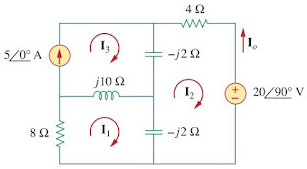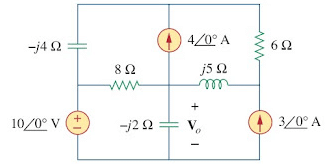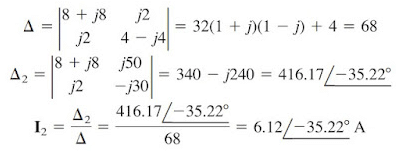Mesh & Supermesh for AC Circuits | Network Theory (Electric Circuits) - Electrical Engineering (EE) PDF Download
Mesh Analysis of AC Circuit
The nodal analysis of ac circuit, we will not cover the basic explanation of its principle. You have to read the link above in order to understand ‘how to use it’ properly.
Let us review the examples below to be able to analyze the ac circuit using mesh analysis.
Determine current Io in the circuit of Figure. using mesh analysis. Example of mesh analysis for ac circuit
Example of mesh analysis for ac circuit
Applying KVL to mesh 1, we obtain
..... (1.1)
For mesh 2,.....(1.2)
For mesh 3, I3 = 5. Substituting this to Equations.(1.1) and (1.2), we obtain..... (1.3)
.....(1.4)
Equations.(1.3) and (1.4) can be rewritten in matrix form as
and its determinants are
The desired current is
Supermesh Analysis of AC Circuit
Next, we will analyze an ac circuit with supermesh within it.
Before doing that, make sure you have understood the principle of supermesh analysis first.
Solve for Vo in the circuit of Figure. with mesh analysis. Example of supermesh analysis for ac circuit
Example of supermesh analysis for ac circuit
As shown above, meshes 3 and 4 form a supermesh due to the current source between the meshes. For mesh 1, KVL results
or......(2.1)
For mesh 2,... (2.2)
For the supermesh,... (2.3)
Due to the current source between meshes 3 and 4, at node A,.... (2.4)
We reduce the above four equations to two by elimination, instead of solving them directly.
Combining Equations.(2.1) and (2.2),.....(2.5)
Combining Equations.(2.2) to (2.4),....(2.6)
Analysis circuit in Figure
From Equations.(2.5) and (2.6), we obtain the matrix equation
We obtain the determinants
Current I1 is obtained as
The required voltage Vo is
|
73 videos|139 docs|62 tests
|
FAQs on Mesh & Supermesh for AC Circuits - Network Theory (Electric Circuits) - Electrical Engineering (EE)
| 1. What is mesh analysis in AC circuits? |  |
| 2. How is mesh analysis different from nodal analysis in AC circuits? |  |
| 3. What is a supermesh in AC circuits? |  |
| 4. How do you handle dependent sources in mesh analysis of AC circuits? |  |
| 5. What are the limitations of mesh analysis in AC circuits? |  |
























